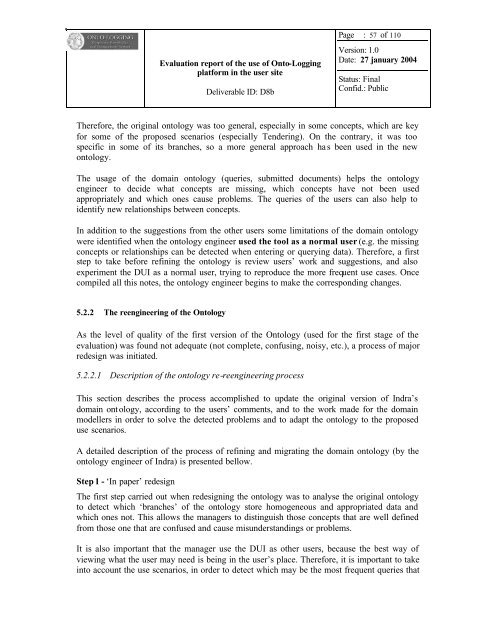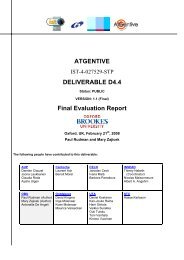pdf 820Kb - INSEAD CALT
pdf 820Kb - INSEAD CALT
pdf 820Kb - INSEAD CALT
You also want an ePaper? Increase the reach of your titles
YUMPU automatically turns print PDFs into web optimized ePapers that Google loves.
Evaluation report of the use of Onto-Logging<br />
platform in the user site<br />
Deliverable ID: D8b<br />
Page : 57 of 110<br />
Version: 1.0<br />
Date: 27 january 2004<br />
Status: Final<br />
Confid.: Public<br />
Therefore, the original ontology was too general, especially in some concepts, which are key<br />
for some of the proposed scenarios (especially Tendering). On the contrary, it was too<br />
specific in some of its branches, so a more general approach ha s been used in the new<br />
ontology.<br />
The usage of the domain ontology (queries, submitted documents) helps the ontology<br />
engineer to decide what concepts are missing, which concepts have not been used<br />
appropriately and which ones cause problems. The queries of the users can also help to<br />
identify new relationships between concepts.<br />
In addition to the suggestions from the other users some limitations of the domain ontology<br />
were identified when the ontology engineer used the tool as a normal user (e.g. the missing<br />
concepts or relationships can be detected when entering or querying data). Therefore, a first<br />
step to take before refining the ontology is review users’ work and suggestions, and also<br />
experiment the DUI as a normal user, trying to reproduce the more frequent use cases. Once<br />
compiled all this notes, the ontology engineer begins to make the corresponding changes.<br />
5.2.2 The reengineering of the Ontology<br />
As the level of quality of the first version of the Ontology (used for the first stage of the<br />
evaluation) was found not adequate (not complete, confusing, noisy, etc.), a process of major<br />
redesign was initiated.<br />
5.2.2.1 Description of the ontology re-reengineering process<br />
This section describes the process accomplished to update the original version of Indra’s<br />
domain ont ology, according to the users’ comments, and to the work made for the domain<br />
modellers in order to solve the detected problems and to adapt the ontology to the proposed<br />
use scenarios.<br />
A detailed description of the process of refining and migrating the domain ontology (by the<br />
ontology engineer of Indra) is presented bellow.<br />
Step 1 - ‘In paper’ redesign<br />
The first step carried out when redesigning the ontology was to analyse the original ontology<br />
to detect which ‘branches’ of the ontology store homogeneous and appropriated data and<br />
which ones not. This allows the managers to distinguish those concepts that are well defined<br />
from those one that are confused and cause misunderstandings or problems.<br />
It is also important that the manager use the DUI as other users, because the best way of<br />
viewing what the user may need is being in the user’s place. Therefore, it is important to take<br />
into account the use scenarios, in order to detect which may be the most frequent queries that
















